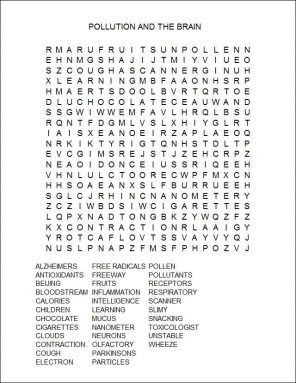Nano air pollutants strike a blow to the brain
Scientists track super-small pollutants that are inhaled into the brain
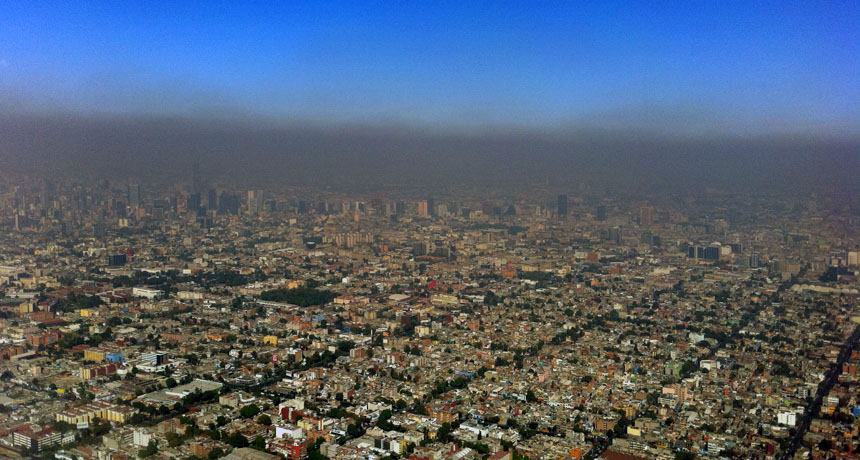
Air pollution cloaks Mexico City in haze. Breathing in this pollution doesn’t just harm the lungs; new studies show it also can damage the brain.
Fidel Gonzalez/Wikimedia Commons (CC BY-SA 3.0)
Cough. Wheeze. Gasp!
Those sounds echo through the streets of polluted cities. Brown clouds made up of noxious gases, dust, soot and even finer particles hang over buildings and hug the ground. When outside, people can’t help but breathe it all in. And in most parts of the world, windows won’t keep these air pollutants out.
Not all large cities have air pollution like this. But in those urban areas where mountains block the wind from clearing the air, such heavily polluted conditions frequently develop. Mexico City often confronts such pollution. So does Beijing, China. And Los Angeles, Calif. With massive populations, these three cities have huge numbers of cars, buses, trucks and factories spewing pollutants into their air.
Air pollution can lead to serious health problems. Wheezing and gasping occur when people breathe in pollutants for long periods of time. Lungful after lungful of contaminated air gums up the respiratory tract. That’s the branching network of tubes that supplies air to the lungs.
Within the respiratory tract, an inner coating of mucus works like fly paper. This slimy secretion traps large particles, such as pollen grains. Small hair-like structures carry this contaminated mucus up and away from the lungs. Coughing and hacking are the body’s way of clearing the airways. A strong cough — or a good swallow — may remove some pollutants completely.

The largest nanoparticles are only 100 nanometers across. Scientists are just starting to understand how soot and other nanoparticles interact with the body. Experts already know these pollutants are small enough to slip inside cells. There, they can damage DNA, proteins and other cellular structures. That leads to all kinds of health problems — and not just in the elderly. Kids experience them, too.
Nanoparticles also damage blood vessels. These ultra-small molecules impair the ability to smell. They can even mess with learning and memory. Brains exposed to nanoparticles develop abnormal features similar to those found in people with Alzheimer’s and Parkinson’s diseases. And that has scientists worried. New data have begun showing how nanoparticles can pollute our brains. Especially alarming, some can make a beeline directly through the nose and into our thought centers.
Sneak attack
If inhaled into the lungs, nanoparticles can enter the bloodstream. From there, these materials travel throughout the body. Some share of them will end up polluting the brain.
A layer of tightly packed cells is supposed to control what can — and can’t — move out of the blood and into the brain. This blood-brain barrier attempts to protect delicate nerve cells, called neurons, from substances that might damage them. Most of the time, the barrier does its job. Nanoparticles, however, slip right through.
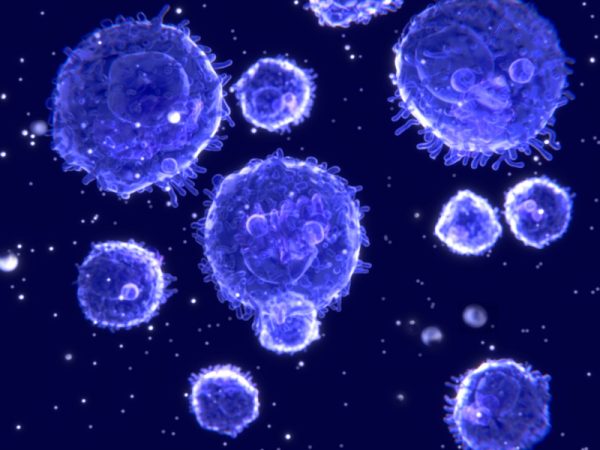
One type of damage is inflammation. Cells attacked by nanoparticles send out a distress signal. The body responds by dispatching white blood cells to the area. White blood cells are part of the body’s immune response. They help fight infection. Soon, the site becomes swollen with blood. Such inflammation occurs not only in the brain, says Finch, but throughout the body.
Inflammation is supposed to be an acute reaction. That means it should occur briefly, then go away. However, when exposure to air pollution is chronic — persistent over time — inflammation, too, can become persistent. And that’s not healthy.
Particularly worrisome: The inflammation triggered by nanopollutants can lead to hardening of blood vessels. Healthy blood vessels are flexible. This allows large amounts of blood to pass through with each contraction of the heart. But as vessels stiffen, blood must squeeze through narrower spaces. Sometimes blood vessels become completely blocked. Then blood flow stops altogether. When that happens in the brain, a person suffers a stroke.
Nanoparticles also can interfere with a nerve cell’s ability to signal to its neighbors. Nerve cells communicate by releasing chemical messengers. These travel to neighboring nerve cells. There they link up with proteins on the outside of a cell, called receptors. Nerve cells can’t understand what their neighbors are trying to tell them if their receptors aren’t working well. And nanoparticles can damage those receptors. This makes them less sensitive to the chemicals — and messages — they need to detect.
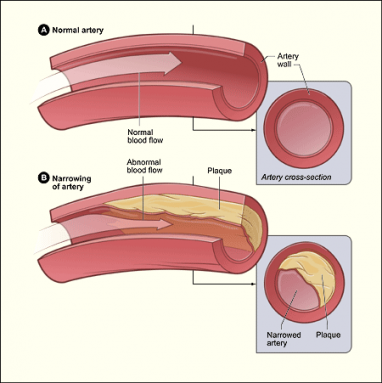
Damage occurs because many nanoparticles contain what chemists call free radicals. That means some of their molecules contain an atom with an unpaired (missing) outer electron. This makes them unstable. In search of a mate for its lone outer electron, a free radical will swipe an electron from some other molecule. This theft transforms the radical into a stable molecule again. In the process, though, its victim now becomes a free radical. As each victim steals an electron from some neighboring molecule, new free radicals form.
The ongoing chain of electron-theft will damage molecules. It can even kill cells. This happens in the lungs and in the brain. The impact of nanoparticles on the brain, in particular, is severe. That is because the particles meddle with our minds. This makes especially worrisome the recent discovery that nanoparticles can make a beeline for the brain.
Direct connection
Hitching a ride through the bloodstream is a long, roundabout way for pollutants to reach the brain. Unfortunately, if pollutants are small enough, they can take a shortcut, notes Alison Elder. She works at the University of Rochester Medical Center in New York. As a toxicologist, she studies how materials can harm the body.
Working with fellow toxicologist Günter Oberdörster, also at Rochester’s Medical Center, Elder tracked the route that nanoparticles take to the brains of rats. Some travel through the blood and cross the blood-brain barrier, she found. Others, however, enter the brain directly through the nose. To get there, the super-tiny toxic chemicals travel along the olfactory (oal-FAK-tur-ee) — scent-sensing — nerves. These line the inside of the nose.
When rats (or people) inhale through their noses, air passes over the olfactory neurons. Odor molecules link up with receptors on these nerve cells. That causes the cells to signal a brain structure called the olfactory bulb. Different nerve cells in the olfactory bulb, called mitral (MY-trul) cells, relay this incoming information about smells to other parts of the brain.
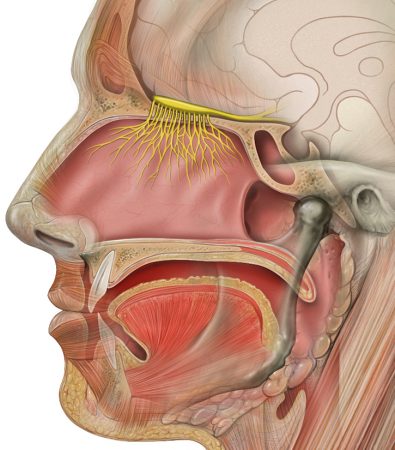
Moving along these sensory neurons, nanoparticles travel straight into the brain by way of mitral cells. Scientists don’t know yet what happens in the nerve cells that allows nanoparticles to travel along them, as if along a highway. Scientists do know, however, what damage the nanoparticles can cause en route. Inside the cells, the particles strip electrons from the atoms that make up cellular structures. This spawns those nasty free radicals.
Nanoparticles also may travel to other parts of the brain. Finch, the biologist at the University of Southern California, exposed mice to air pollution collected near a Los Angeles freeway. Then he examined their brains. Effects of the nanoparticles showed up throughout. Particularly concerning: damage to the hippocampus. This part of the brain is involved in learning and remembering new things.
Sniffing out the problem
Damage to parts of the brain that learn and remember things doesn’t just happen in rodents. Nanopollutants can damage the brains of people, too. Brain injury has shown up even in children. Lilian Calderón-Garcidueñas has seen it. She is a toxicologist at the University of Montana in Missoula. As a pathologist, she also studies the effects of disease on the body’s cells and tissues.

Calderón-Garcidueñas has been testing the ability of children and young adults to smell a variety of odors. Some scents are strong, others weak. Over time, young people living in heavily polluted Mexico City lose some of their ability to smell, she is finding.
That’s bad news, she points out. Loss of smell is one of the first symptoms of Alzheimer’s and Parkinson’s diseases. Indeed, that made her wonder whether damage to the olfactory bulb might be an early warning of more severe problems elsewhere in the brain. And she had good reason to think it might.
Earlier, she had examined the brains of stray dogs in Mexico City. She also had studied the brains of city residents, young and old, who had died in auto accidents or from other types of traumatic events. All showed an accumulation of the same proteins that are also seen in the brains of patients with Alzheimer’s or Parkinson’s disease. Even in families with a history of these diseases, people usually don’t develop those proteins before they turn 40. But in Mexico City, the proteins emerged even in the brains of young children. Their presence might signal harm to thought-processing regions.
It would be impossible to test the impact of these changes on thought or memory in people who had died. So Calderón-Garcidueñas looked for something she could scout for in living folks. And she came up with two things: IQ and computerized scans of the brain.
Calderón-Garcidueñas started by giving an intelligence test to children living in Mexico City. She also tested kids who were the same age but living in a less polluted town. Children in the cleaner town performed better on every aspect of the intelligence test.
Next, she scanned the kids’ brains using an MRI scanner. (MRI is short for magnetic resonance imaging.) The scanner takes a picture of the brain.
Those scans showed areas of damage in the brains of all but one of the Mexico City kids. Children living where the air was cleaner had healthy brains. These findings, says Calderón-Garcidueñas, show that air pollution can start ravaging the brains of even young people.
What you can do
Improving air quality would go a long way toward improving health, Calderón-Garcidueñas concludes. But getting rid of air pollution won’t happen quickly or easily. Luckily, there are things that kids and their families can do to protect themselves even if they can’t escape dirty air.

Snacking on fruits and vegetables also helps. These power foods play an important role in fighting damage by free radicals. That’s because many of those foods contain antioxidants, explains Calderón-Garcidueñas. Antioxidants donate an electron to free radicals without becoming unstable. That stops the destructive chain reaction in its tracks.
If you have to indulge your sweet tooth, choose chocolate over other candies. And not just any chocolate. Dark chocolate is chockablock with antioxidants that can help keep the brain — and the body — up and running. Just don’t overdo it: The sugar in most chocolate just adds unwanted calories.
Power Words
acute An conditions, such as an illness (or its symptoms, including pain), that is typically short in duration but severe.
Alzheimer’s disease An incurable brain disease that can cause confusion, mood changes and problems with memory, language, behavior and problem solving. No cause or cure is known.
antioxidant Any of many chemicals that can shut down oxidation — a biologically damaging reaction. They do this by donating an electron to a free radical (a reactive molecular fragment) without becoming unstable. Many plant-based foods are good sources of natural antioxidants, including vitamins C and E.
autopsy Examination of body tissues after a person dies, typically performed to determine the cause of death.
blood-brain barrier A barrier of tightly packed cells that carefully regulate what molecules can — and can’t — enter the brain. The barrier protects the brain from foreign substances in the blood and helps to maintain a constant environment for brain cells.
chronic A condition, such as an illness (or its symptoms, including pain), that lasts for a long time.
free radical A charged molecule (typically highly reactive and short-lived) having an unpaired outer electron.
hippocampus A seahorse-shaped region of the brain. It is thought to be the center of emotion, memory and the involuntary nervous system.
immune system The collection of cells and their responses that help the body fight off infection.
immunity The ability of an organism to resist a particular infection or poison by producing and releasing special protective cells.
infection A disease that can spread from one organism to another.
inflammation The body’s response to cellular injury; often involves swelling, redness, heat and pain.
magnetic resonance imaging (MRI) An imaging technique to visualize soft, internal organs, like the brain, muscles, heart and cancerous tumors. MRI uses strong magnetic fields to record the activity of individual atoms.
mitral cells Cells located in the olfactory bulb (a region of the brain) that relay information about smell to various regions of the brain.
nanoparticle A small particle measured in the billionths of a meter.
neuron (or nerve cell) Any of the impulse-conducting cells that make up the brain, spinal column and nervous system. These specialized cells transmit information to other neurons in the form of electrical signals.
olfaction Sense of smell.
olfactory bulb A region of the brain that detects incoming information about smell.
Parkinson’s disease A disease of the brain and nervous system that causes tremors and affects movement, memory and mood.
pathology The study of diseases and/or conditions that lead to death. People who work in this field are called pathologists. They look at what causes a disease, how symptoms develop and may examine all stages of an illness.
receptor (in biology) A molecule in cells that serves as a docking station for another molecule. That second molecule can turn on some special activity by the cell.
respiratory tract Parts of the body involved in breathing (also called the respiratory system). It includes the lungs, nose, sinuses, throat and other large airways.
stroke (in biology and medicine) A condition where blood stops flowing to part of the brain or leaks in the brain.
toxicology The branch of science that probes poisons and how they disrupt the health of people and other organisms.
trauma (adj. traumatic) Serious injury or damage to an individual’s body or mind.
urban Of or related to cities, especially densely populated cities or regions where lots of traffic and industrial activity occurs.
white blood cells Blood cells that help the body fight off infection.
